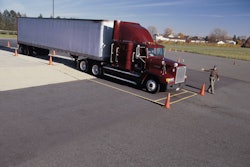
Register now for this critical webinar on April 20
Over the three day-long Commercial Vehicle Safety Alliance’s International Roadcheck commercial motor vehicle inspection and enforcement initiative last year, CVSA-certified inspectors conducted 59,026 inspections and placed 12,456 commercial motor vehicles out of service nationwide. This year’s enforcement blitz will take place May 16-18, and in this webinar on April 20 at 1:00 p.m. Central — sponsored by Mann+Hummel — we will discuss the top OOS violations (namely brakes, lights and tires), and what drivers and the shop should be doing to catch these faults before enforcement officers do.
Brakes are annually a top out of service violation during Commercial Vehicle Safety Alliance's (CVSA) International Roadcheck, and this year will get special emphasis during the campaign in May.
A high-visibility, high-volume 72-hour inspection and enforcement event Roadcheck will have CVSA-certified inspectors in Canada, Mexico and the U.S. focus on anti-lock braking systems (ABS) and cargo securement to highlight the importance of those aspects of vehicle safety.
Although ABS violations are not out of service (OOS) violations, ABS reduces the risk of collision by preventing the wheels from locking up or skidding, allowing a driver to maintain control of the vehicle while braking. Brakes (brake systems, 25.2% and defective service brakes, 12.7%) were two of the top three OOS violations in last year's inspection campaign.
Improper cargo securement poses a serious risk to drivers and other motorists by adversely affecting the vehicle’s maneuverability, or worse, causing unsecured loads to fall, resulting in traffic hazards and vehicle collisions. Cargo securement was the No. 5 OOS violation in last year's enforcement blitz, making up more than 10% of all OOS violations.
This year's campaign is set for May 16-18 and inspectors will conduct inspections of commercial motor vehicles and drivers at weigh/inspection stations, designated inspection areas and along roadways. During International Roadcheck, inspectors will also conduct their usual roadside safety inspections of commercial motor vehicles and drivers. Data will be gathered from those three days and shared later this year, as a snapshot of the state of commercial motor vehicle and driver safety.
During a routine North American Standard Level I Inspection, inspectors focus on two areas: driver and vehicle safety compliance.
Vehicle safety
Inspectors will ensure the vehicle’s brake systems, cargo securement, coupling devices, driveline/driveshaft components, driver’s seat, fuel and exhaust systems, frames, lighting devices, steering mechanisms, suspensions, tires, wheels, rims, hubs and windshield wipers are compliant with regulations. Inspections of motorcoaches, passenger vans and other passenger-carrying vehicles also include emergency exits, seating, and electrical cables and systems in the engine and battery compartments.Driver safety
Inspectors will check the driver’s operating credentials, hours-of-service documentation, status in the drug and alcohol clearinghouse, seat belt usage, and for alcohol and/or drug impairment.Vehicles that successfully pass a Level I or Level V Inspection without any critical vehicle inspection item violations may receive a CVSA decal, which is valid for three months. If the inspector does identify critical vehicle inspection item violations, as outlined in the North American Standard Out-of-Service Criteria, the vehicle will be restricted from operating until the identified out-of-service conditions have been corrected. Inspectors may also restrict the driver from operating if the driver is found to have driver out-of-service violations, such as not possessing a valid or necessary operating license or exhibiting signs of impairment.










